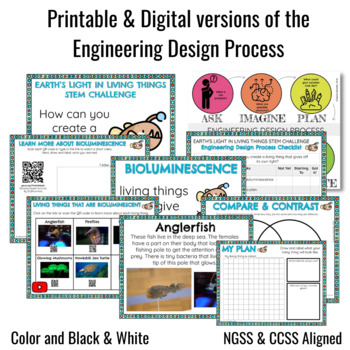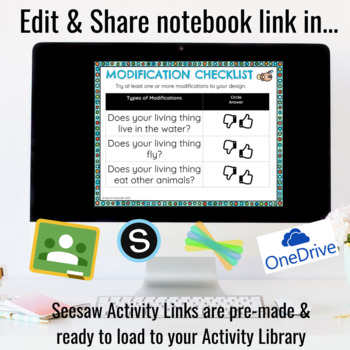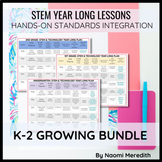Bioluminescent Animals and Plants | Earth's Light in Living Things STEM
- Zip
- Google Apps™
- Microsoft OneDrive

Also included in
- Needing 1st grade STEM project ideas? In this growing bundle, lessons are one of a kind and have been used with real students before being added. They can be implemented in any classroom setting, not just STEM classrooms. Save time by using lessons already integrated with cross-curricular connectionPrice $56.60Original Price $70.75Save $14.15
- Needing Kindergarten, 1st & 2nd grade STEM project ideas? In this growing bundle, lessons are one of a kind and have been used with real students before being added. They can be implemented in any classroom setting, not just STEM classrooms. Save time by using lessons already integrated with croPrice $145.40Original Price $181.75Save $36.35
- Needing K-5 STEM project ideas? In this growing bundle, lessons are one of a kind and have been used with real students before being added. They can be implemented in any classroom setting, not just STEM classrooms. Save time by using lessons already integrated with cross-curricular connections. AllPrice $281.40Original Price $351.75Save $70.35
- Learn more about Earth by exploring its processes and living things. Have hands-on, STEM experiences where students can design solutions, modify their designs, and share their work. A variety of lessons for K-5. ==========================================STEM Challenges are a great way to encourage cPrice $29.00Original Price $42.00Save $13.00
Description
On Earth, there are a handful of living things that produce their own light called bioluminescence. How can you create a living thing that gives off its own light? By going through the Engineering Design Process, you’ll explore different living things that are bioluminescent, plan and create your own living thing that produces light, make modifications and share your creation. Print-and-go and digital resources to guide creation and exploration.
==========================================
STEM Challenges are a great way to encourage creativity, collaboration and critical thinking. With the tools that I created for you, it should save you time with prep and give you more time to provide an awesome experience for your kids.
==========================================
Go through the Engineering Design Process
- STEM Challenge Card
- Task Designing Checklist to keep track of work
- Learn More About Bioluminescent Living Things Audio/Mini Article/Images Links with Reflection (anglerfish, fireflies, comb jellies, glowing mushrooms, hawksbill sea turtle, yellow-coated clusterwink)
- Planning Sheet for living thing creation
- Checklist for ways students can improve their design
- Student Sheet to attach final design and explain
- End of activity reflection sheet
==========================================
Bonus Anchor Charts!
- Engineering Design Process
==========================================
The resources NOT included that you will need for this STEM challenge are:
- various Makerspace items that students can build with
- small glow sticks or small flashlights
- masking tape
- straws
- popsicle sticks
- pipe cleaners
- felt/fabric
- small plastic cups
- construction paper
- googly eyes
=========================================
Next Generation Science Standards (NGSS):
1st Grade:K-2-ETS-1, K-2-ETS-2, K-2-ETS-3, 1-PS4-2
2nd Grade: K-2-ETS1-1-3, 2-ESS2-1
Common Core State Standards:
1st Grade: RI.1.6, RI.1.10, W.1.6, W.1.8, SL.1.1
2nd Grade: RI.2.5, RI.2.10, W.2.6, W.2.8, SL.2.1, SL.2.1b, SL.2.5
Mathematical Practices
MP6- Attend to Precision
ISTE Standards for Students
Knowledge Constructor
=========================================
How you will receive this product:
Various digital file types to meet your sharing needs
- PDF (non-editable, various sizes)
- Google Slides link
- PowerPoint file
- Seesaw activity
All Seesaw files are pre-loaded into activities. Upon purchase, you'll get the share link to copy & edit and add to your Seesaw Activity library, then assign to students. I saved you A LOT of steps!
How to assign digital versions to students:
- Google Slides pair perfectly with Google Classroom. Once you click the button, it will automatically make a copy for each student
- PowerPoint works well with Microsoft OneDrive users. Share with students within Microsoft Teams
- Seesaw Activities can be assigned to students and automatically make a copy. You can also use the Google Slides version if you students log in with their Google account
===========================================
When you purchase a product from my store, a portion of the proceeds will be donated to classrooms in need of technology to enhance their students’ learning experience.
===========================================
Want to try out the STEM Survival Camp Challenges? Click here to check them out!
===========================================
Connect with me for more inspiration!
Naomi Meredith
Navigating STEM & tech in the K-5 classroom.
Click here to be updated when new products are posted.
Instagram: @naomimeredith_
Questions? Email me: contactnaomimeredith@gmail.com









